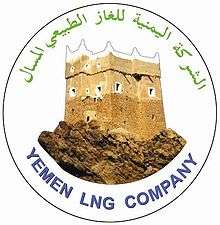Yemen LNG

Yemen LNG (also called YLNG) is the first 'natural gas liquefaction (LNG) project in Yemen. The LNG plant is located in Balhaf.
History
Yemen LNG Company was incorporated in 1995 to develop the LNG plant. In 1997, the development was halted because of the Asian economic crisis.[1][2] The project was launched only in August 2005 after signing three LNG supply contracts.[3] On 29 October 2007, Yemen LNG and Yemen state-owned oil and gas company Safer Exploration and Production agreed a 20-year contract, according to which Safer grants the LNG plant with supply up to 12.5 billion cubic meter (bcm) of gas per year from the Block 18 of the Marib-Jawf field.[4] The production started on 15 October 2009.[5][6]
Technical description
The project comprises upstream gas processing facilities including a transfer line linking processing units, a spur-line for transporting gas to the Ma'bar area and a 320 kilometres (200 mi), 38 inches (970 mm) pipeline connecting the gas processing facilities to the LNG plant. The plant consists of two LNG trains with the total capacity of 6.7 million tonnes per year.[5] The contractors for the construction of LNG trains were Technip, JGC, and Kellogg Brown & Root.[7] The project is one of the country's first big project financing with total cost of US$4 billion, involving US$3 billion in debt being raised from a syndicate of banks.[8][9] Bank of Tokyo-Mitsubishi UFJ, BNP Paribas, Citigroup, ING Group, Royal Bank of Scotland, Société Générale, and Sumitomo Mitsui Banking Corporation are the initial mandated lead arrangers and bookrunners on a loan.[10]
Project company
The consortium is led by Total S.A. (39.62%) in cooperation with Hunt Oil Company (17.22%), Yemen Gas Company (YGC; 16.73%), SK Corp. (9.55%), Kogas (6.00%), Hyundai Corporation (5.88%), and the General Authority for Social Security & Pensions of Yemen (5.00%).[5][6] On 30 June 2010, Russia's government announced that Russian gas company Gazprom may buy Hunt Oil's stake, possibly together with Saudi Arabia.[11]
LNG exports
Yemen LNG has SPAs to supply:
- Suez — 2.5 mtpa,
- Total S.A. — 2.0 mtpa,
- Kogas — 2.0 mtpa.
All SPAs last from 2009–2029.
References
- ↑ "MOU Signed Between Yemen LNG and BG for Pipavav Project" (Press release). BG Group. 1998-05-05. Retrieved 2008-02-15.
- ↑ Willems, Peter (2004-09-27). "Yemen LNG is optimistic about the future". Yemen Times. Retrieved 2008-02-15.
- ↑ "Yemen LNG Development Launched". Rigzone. 2005-08-29. Retrieved 2008-02-15.
- ↑ "Yemen Safer to conclude LNG gas deal end Nov-exec". Reuters. 2007-10-29. Retrieved 2008-02-15.
- 1 2 3 Boselli, Muriel (2009-10-15). "Five facts about Yemen LNG". Reuters. Retrieved 2009-10-17.
- 1 2 True, Warren R. (2009-10-15). "Yemen LNG yields first production into glutted market". Oil & Gas Journal. 107. PennWell Corporation. Retrieved 2009-10-17.
- ↑ Shirkhani, Nassir (2006-12-04). "Yemen LNG on starting blocks". Upstream Online. NHST Media Group. Retrieved 2007-08-05. (subscription required (help)).
- ↑ Mangham, Christopher (2008-02-13). "RLPC-Yemen LNG selecting banks for project loan-bankers". Reuters. Retrieved 2008-02-15.
- ↑ "Yemen LNG players line up lenders". Upstream Online. NHST Media Group. 2008-03-07. Retrieved 2008-03-07. (subscription required (help)).
- ↑ Watkins, Eric (2008-03-10). "Total-led Yemen LNG arranges LNG project financing". Oil & Gas Journal. 106. PennWell Corporation. Retrieved 2008-03-11.
- ↑ Bryanski, Gleb (2010-06-30). "Russia's Gazprom eyes Hunt stake in Yemen LNG project". Reuters. Retrieved 2010-06-30.
Coordinates: 13°59′07″N 48°10′49″E / 13.9854°N 48.1802°E